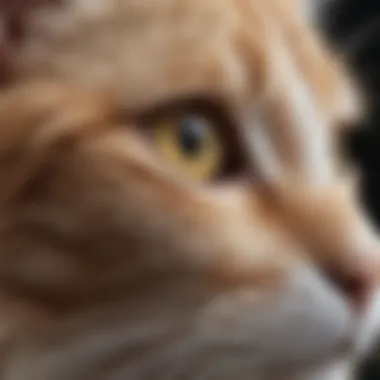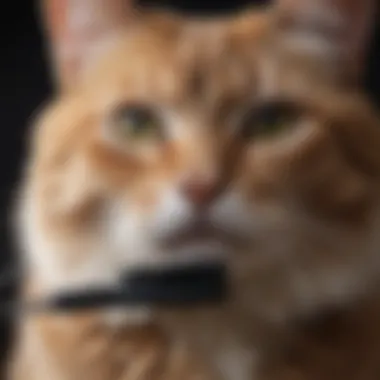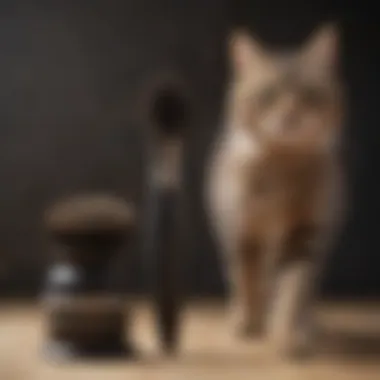Top Brushes to Effectively Remove Cat Hair


Intro
Removing cat hair from your home can be a daunting task for cat owners. With various cat breeds possessing unique fur types, the choice of grooming tools plays a crucial role in managing shedding. This guide aims to demystify the process of selecting the best brush for cat hair removal, assessing various brushes tailored for different situations. Understanding cat behavior and grooming needs can enhance the experience for both the owner and the pet, leading to more effective fur management and a cleaner environment.
Fascinating Facts About the Animal
Unique Characteristics
Cats exhibit a wide array of fur types and textures. Long-haired breeds, like the Persian, have dense, flowing coats, while short-haired cats, such as the American Shorthair, possess a more manageable fur type. Each breed's fur requires different grooming techniques and tools for effective maintenance. Knowing these characteristics helps in choosing a brush that can tackle specific shedding issues.
Extraordinary Abilities
Cats are renowned for their agility and sensitivity. They excel in balancing and can often spring back to safety if they fall. Their reflexes and senses enable them to thrive in their environments, hence, the need for regular grooming helps in keeping their fur in optimal condition. Keeping a clean coat is not just about aesthetics; it can significantly affect a cat's health by reducing matting and skin maladies.
Behavior and Habitat
Natural Habitats
Domestic cats have adapted well to various environments, from small apartments to sprawling homes. Their natural instinct to groom plays a significant role in their health. Regular brushing can mimic their grooming habits, promoting a bond between cat and owner while helping prevent hair from accumulating in the living space.
Social Structures
Cats display different social behaviors based on their surroundings. Some cats enjoy solitary moments while others thrive on interaction with family members. Understanding your cat's personality can help determine when and how to groom them. A gentle brush can also serve as a tool for comfort, allowing for a relaxing experience for both pet and owner.
Recent Scientific Discoveries
Latest Research Findings
Recent studies in feline grooming patterns reveal that certain brush types can stimulate improved blood circulation and skin health. For instance, rubber brushes often work well for short-haired cats to effectively remove loose fur and debris. This information is essential since it supports the overall wellbeing of pets during the grooming process.
Breakthroughs in Animal Biology
Research highlights that cats’ fur contains proteins that can influence their overall health status. A clean coat aids in keeping the skin healthy and provides effective insulation. This makes selecting the right brush more than just an aesthetic choice—it becomes part of a broader strategy in maintaining a cat’s health.
Cultural Significance
Animals in Folklore
Cats have held symbolic importance in various cultures worldwide. From being revered in ancient Egypt to acting as omens, they have been integrated into folklore that spans centuries. This perspective can often mesh with modern-day views of responsibility in pet ownership, suggesting that nurturing and grooming cats go beyond the mere maintenance of cleanliness.
Influence on Art and Literature
Throughout history, cats have inspired countless works of art and literature. They symbolize independence and grace, and their grooming habits are often depicted as a crucial part of their allure. This cultural significance brings to light the responsibilities associated with cat ownership, connecting the act of grooming with the deeper appreciation of their companionship.
Understanding Cat Hair
Understanding cat hair is essential for every cat owner. It plays a significant role in determining grooming practices and choosing effective tools. Recognizing the unique nature of cat fur helps in selecting brushes that best suit the cat's fur type. This knowledge empowers owners to keep their cats healthy and their homes clean. It is necessary to delve deeper into the subject of cat hair to make informed choices about grooming needs.
The Nature of Cat Fur
Cat fur consists of several types of hair strands: guard hairs, undercoat hairs, and awn hairs. Guard hairs are longer, coarser, and serve as the first line of defense against elements such as water and dirt. The undercoat is finer and softer, providing warmth and insulation. Awn hairs are intermediate in texture and length. Understanding these layers is crucial as cats with dense undercoats can shed more than those with single coats. For example, breeds like the Maine Coon or the Persian typically have denser fur, requiring specific grooming tools and techniques.
The structure of cat fur also affects how it responds to brushing. Some brushes are designed to penetrate the dense fur, while others are meant to smooth the top layer. By knowing your cat’s fur type, you can choose a grooming tool that effectively minimizes shedding and maintains the coat's health.
Why Cats Shed
Shedding is a natural process for cats and can occur due to various factors. Seasonal changes trigger shedding, as cats lose their winter coat in spring and grow it back in the fall. However, shedding can also be influenced by stress, diet, and overall health. For instance, a diet lacking essential nutrients can lead to excessive shedding, which may indicate underlying health issues.
Moreover, indoor cats may shed differently than outdoor cats due to exposure to artificial light and temperature variations. Understanding these factors can help owners create a suitable grooming schedule. Practicing regular grooming not only reduces the amount of cat hair in the home but also promotes a healthy skin and coat. In addition, it allows owners to monitor their cats for signs of skin irritations or abnormalities, fostering a proactive approach to their pet’s well-being.
Regular grooming can significantly reduce the amount of loose hair and dander in your home, contributing to a cleaner environment.
Importance of Grooming


Grooming plays a crucial role in the overall health and well-being of cats. Not only does it keep their coat looking tidy, but it also has significant health benefits. Regular grooming reduces the risk of skin problems and promotes better circulation. For cat owners, it offers a way to bond with their pets, making the process more enjoyable for both parties. Grooming also helps to minimize shedding and, consequently, hair spread throughout the home.
Health Benefits for Cats
Grooming your cat regularly is essential for their health. It helps in detecting early signs of skin issues or parasites, which can lead to serious health problems if left untreated. When you brush your cat, you are actually stimulating the skin and promoting the production of natural oils. These oils protect the skin and fur, keeping it nourished and shiny.
Additionally, cats that are groomed frequently experience less matting of their fur. Matted fur can lead to discomfort and even skin infections. Older cats or those with certain health conditions may require more attention, as their ability to groom themselves diminishes. Therefore, a consistent grooming routine can play a vital role in maintaining their health.
Maintaining a Clean Home
Grooming your cat effectively benefits your living environment as well. Regular brushing significantly reduces the amount of loose hair and dander in your home. This can be particularly advantageous for people who have allergies or respiratory issues, as it helps to maintain cleaner air. When cat hair is left unaddressed, it can accumulate and create an unclean atmosphere.
Moreover, a clean home reflects well on the owner's attention to both their pet and their surroundings. By investing time in grooming, cat owners can create an inviting space. This practice can also lessen the frequency of vacuuming, saving time and energy in maintaining the home.
In summary, grooming is not just a beauty routine but a necessary aspect of pet care that impacts both the health of cats and the cleanliness of their homes. Regular grooming reflects responsible pet ownership and contributes to a happier, healthier feline.
Types of Brushes for Cat Hair Removal
Choosing the right brush for removing cat hair is critical for effective grooming. Different brushes have distinct designs, and knowing which is best for your cat can significantly improve the grooming process. Each type of brush serves a specific purpose and offers unique benefits, making it important for cat owners to understand their options.
An effective grooming tool not only helps to remove loose fur but also aids in reducing allergies and maintaining a clean home environment. By familiarizing yourself with the different types of brushes available, you can select one that meets both the grooming needs of your cat and your own preferences for ease of use.
Slicker Brushes
Slicker brushes have fine, short wires close together on a flat surface. Their design is made to catch and remove loose hair and matting, making them especially useful for long-haired breeds. Regular use of a slicker brush can help reduce shedding around your home while also ensuring your cat's coat remains healthy and free of tangles.
In addition to their functional aspect, slicker brushes are very versatile. They can reach through multiple layers of fur, which is beneficial for cats with thick undercoats. However, care should be taken to avoid skin irritation. For thorough cleaning, use a slicker brush at least once a week.
Rubber Brushes
Rubber brushes are unique due to their soft, flexible bristles. They work effectively to remove loose hair and dirt from a cat's coat while being gentle on the skin. This makes them ideal for cats with sensitive skin or those that resist traditional brushes.
Aside from their comfort, rubber brushes can also be used during bathtime. They assist in lathering shampoo while effectively removing dead fur. They are easy to clean as well, which adds to their appeal. Due to these characteristics, rubber brushes are often favored by owners of cats who dislike grooming.
Undercoat Rakes
Undercoat rakes are specialized tools designed to remove undercoat fur. Their unique structure features long, widely spaced teeth that glide through the top layer of fur and reach directly into the undercoat. This is particularly useful for double-coated breeds such as Siberian or Norwegian Forest cats.
When using an undercoat rake, it’s important to focus on specific areas, especially where matting may occur. Using this tool regularly can reduce excessive fur accumulation and promote better air circulation to the skin. Like other brushes, it's advised to be gentle to avoid causing any discomfort.
Deshedding Tools
Deshedding tools come in various designs, but they all share a common goal: to reduce shedding. These tools feature fine teeth that catch dead hair before it gets shed into your home. They are somewhat similar to slicker brushes but specifically designed to remove undercoat fur efficiently.
Using deshedding tools can make a noticeable difference during shedding seasons. Many owners find that incorporating a deshedding tool into their grooming routine results in less fur on furniture and floors. However, it’s essential to use these tools as directed to avoid irritation.
By understanding the characteristics and benefits of each type of brush, you can make informed choices that align with your cat's grooming requirements and your home’s cleanliness. The next step involves evaluating key features of these brushes to further refine your selection.
Key Features to Consider
When selecting a brush for removing cat hair, several key features should be evaluated. These features contribute to the effectiveness of the grooming tool. Understanding these aspects can significantly enhance both the grooming process and the comfort of your cat.
Material Quality
Material quality is a fundamental criterion when choosing a grooming brush. Brushes with high-quality materials tend to be more durable and effective at removing loose fur. Common materials used in brush construction include metal, plastic, and natural fibers. Each material has its strengths. For instance, metal bristles can penetrate deeper into the coat, effectively capturing more shedding fur. On the other hand, rubber brushes are softer and gentler, making them ideal for sensitive skin. The durability of the brush also correlates with the quality of materials used. Investing in a well-made product means it will last longer and withstand regular use without losing effectiveness.
Ease of Use
The ease of use is another important factor to consider. A brush that is user-friendly can significantly improve the grooming experience for both the cat and the owner. Look for features such as a comfortable handle that provides a good grip, as this helps prevent hand fatigue during longer grooming sessions. Additionally, consider how easy the brush is to clean. Brushes designed with removable fur compartments or those that can be cleaned with minimal effort save time and enhance usability. An easy-to-handle brush promotes more frequent grooming, which benefits the overall health of the pet.
Size and Shape
The size and shape of the brush directly impact its effectiveness. Brushes come in various sizes, suitable for different cat breeds and fur lengths. A larger brush may cover more area in a short time, but a smaller, narrow-bristled brush can reach sensitive or difficult areas, such as behind the ears or under the chin. The shape of the brush head also matters; some are designed with rounded edges or specific angles to better conform to the contours of a cat's body. Evaluating your cat’s specific grooming needs will help you select a size and shape that works best for both you and your pet.
Each feature plays a critical role in the overall grooming process. Neglecting any one aspect could lead to ineffective grooming and discomfort for your cat.


How to Choose the Right Brush
Selecting the right brush is crucial for effective grooming and hair removal. Understanding your cat's specific needs can lead to more satisfying results both for you as an owner and for your feline friend. Different fur types require distinct approaches, and the right tools can help manage shedding and maintain skin health. It is essential not only to keep your home clean but also to ensure a positive grooming experience for your cat.
Choosing a brush involves careful evaluation of several factors. These include your cat's fur type, individual grooming preferences, and the overall effectiveness of the brush in meeting your requirements. The decision can significantly enhance the grooming process and contribute to a more manageable living environment.
Assessing Your Cat's Fur Type
When choosing a brush, one of the first steps is to assess your cat's fur type. Cat fur can vary greatly; some cats have short coats while others boast long, thick fur. Each fur type requires different tools to address shedding effectively. Here are several common fur types:
- Short Hair: Breeds like the American Shorthair require brushes with soft bristles that can remove loose hair without irritating the skin.
- Medium Hair: Cats such as the British Longhair benefit from tools that can effectively detangle and remove undercoat fur. Slicker brushes can be especially helpful here.
- Long Hair: For breeds like the Persian, a combination of a wide-toothed comb and a slicker is often most effective. These protect against matting while enabling thorough grooming.
It's vital to evaluate how often your cat sheds and whether they possess any undercoat. This assessment will inform what type of brush will work best, ensuring you make an informed decision.
Understanding Personal Preferences
In addition to fur type, understanding personal preferences is also important when selecting a brush. Both you and your cat should feel comfortable during grooming. For this, consider the following:
- Ergonomics: Look for brushes that are easy to hold and maneuver. An ergonomic design can significantly reduce discomfort during grooming sessions.
- Weight: The weight of the brush can affect grooming duration and ease. Lighter brushes can be easier to use for longer brushing sessions.
- Cat's Reaction: Pay attention to how your cat responds when being groomed. Some cats may prefer specific styles of brushes, such as rubber options that feel more gentle on their skin. It may take time to find the right tool that satisfies both your comfort and your cat's preferences.
Ultimately, ensuring that both you and your cat enjoy the grooming experience can enhance your relationship. Regular grooming not only keeps your home free from excess fur, but it also provides an opportunity for bonding.
"The right brush can transform grooming from a chore into a positive experience for both you and your cat."
By assessing your cat's fur type and taking personal preferences into account, you can select the most suitable brush. This selection will lead to an effective grooming routine that benefits both parties.
Best Brush Recommendations
Selecting the right brush for cat hair removal is crucial for both the cat’s well-being and maintaining a clean home environment. Several brush types cater to different fur textures and grooming needs, which makes understanding these options essential. An informed selection can significantly reduce shedding while enhancing the bonding experience during grooming sessions.
Top Slicker Brushes
Slicker brushes are highly regarded for their effectiveness in removing loose hair and detangling mats. These brushes feature fine, bent wires close together, which can penetrate deep into the coat to catch loose fur.
- Benefits: Slicker brushes are particularly beneficial for long-haired breeds. They help in minimizing the appearance of tangles, ensuring an overall smoother coat.
- Considerations: When choosing a slicker brush, consider the size of the brush and the distance between the bristles. Opt for a brush that suits your cat's size and fur density. Brands such as Hertzko and Safari offer popular options with ergonomic designs, enhancing comfort during grooming sessions.
Best Rubber Brushes
Rubber brushes are favored for their gentle interaction with a cat’s skin. The rubber bristles attract loose hair and dander while massaging the skin, which can be enjoyable for cats.
- Benefits: Besides effective hair removal, rubber brushes can also stimulate the skin, promoting a healthy coat and reducing shedding. This makes them especially useful for short-haired breeds.
- Considerations: Look for brushes with flexible rubber bristles that conform to your cat's body. The Kong Cat Zoomgroom is a recommended product in this category, known for its effectiveness in catching loose fur while being kind to the skin.
Effective Undercoat Rakes
Undercoat rakes are designed specifically for cats with thick undercoats. Their unique structure allows them to penetrate the top layer and effectively remove the undercoat without damaging the outer fur.
- Benefits: These brushes are essential during seasonal shedding periods when cats lose their undercoat. Regular use can help reduce the amount of shedding in the home.
- Considerations: Using an undercoat rake requires some technique. It's important to brush in the direction of hair growth to avoid pulling on the cat's skin. The Furminator Undercoat Rake is a highly-rated option that provides excellent results while maintaining coat integrity.
Recommended Deshedding Tools
Deshedding tools have gained popularity among pet owners for their ability to reduce shedding significantly. They come in various designs, typically featuring a fine blade that removes dead hair and undercoat.
- Benefits: Regular use of deshedding tools can decrease shedding by up to 90%, preventing fur from accumulating on furniture and clothing. Additionally, these tools provide a thorough grooming experience that keeps the cat comfortable.
- Considerations: It is beneficial to choose a deshedding tool appropriate for your cat’s coat type. For instance, the FURminator deShedding Tool is well-suited for both long and short hair, offering options based on the cat's fur length.
When selecting grooming tools, consider your cat's specific needs, including fur type and sensitivity.
Grooming Techniques
Grooming techniques are a fundamental aspect of cat care that can significantly enhance the well-being of your pet. Establishing a consistent grooming routine not only helps keep your home free from fur but also supports the health of your cat. Through effective grooming methods, you can identify skin issues early, strengthen your bond with your cat, and improve their overall comfort. The following subsections delve into the essential elements of grooming, focusing on the significance of maintaining a regular grooming schedule and utilizing proper brushing techniques.
Regular Grooming Schedule
Creating a regular grooming schedule is key to managing cat hair effectively. It is advisable to brush your cat at least once a week, though more frequent grooming may be required for cats with longer or thicker fur. By maintaining this routine, you can:


- Reduce Shedding: Regular brushing removes loose hair before it ends up on your furniture and clothing.
- Enhance Skin Health: Grooming stimulates the skin and distributes natural oils, promoting a healthy coat.
- Detect Health Issues: Regularly inspecting your cat's skin during grooming can help spot conditions like parasites or skin irritations early.
Additionally, the type of brush used may affect how often grooming should take place. For instance, slicker brushes could be more effective for certain fur types and may warrant a more frequent schedule. Consider observing your cat's reaction to grooming sessions to adjust the frequency if needed.
"A well-groomed cat is a happy cat. Establishing good grooming habits early can help reduce discomfort and anxiety during these sessions."
Proper Brushing Techniques
Understanding proper brushing techniques is crucial in ensuring that grooming is effective and pleasant for your feline companion. Here are some guidelines to consider:
- Start Slow: Begin grooming each session with gentle strokes. Allow your cat to acclimate to the brush.
- Follow the Fur Direction: Brush in the direction of hair growth. This technique minimizes discomfort and prevents pulled hairs.
- Avoid Sensitized Areas: Pay attention to sensitive areas like the belly or behind the ears. Cats may prefer these regions to be brushed lightly or avoided completely.
- Be Gentle: Use a light hand, especially on tangles or knots. Pulling too hard can cause pain and discourage your cat from future grooming.
- Reward Technique: Use treats or positive reinforcement to create a positive association with grooming. This method encourages cats to be more cooperative and often helps them enjoy the experience.
By employing these brushing techniques consistently, you will not only maintain optimal fur health but also ensure that your cat remains relaxed and comfortable during grooming sessions. The effectiveness of your grooming routine will significantly influence both the results and your relationship with your cat.
Dealing with Sensitive Skin
Dealing with sensitive skin is a critical aspect of grooming cats. Not all cats have the same skin type. Some have skin that reacts easily, which can lead to discomfort or injury during brushing. It's vital for cat owners to recognize skin sensitivity to provide the best grooming experience for their pets. Proper identification and selection of grooming tools are essential.
Identifying Skin Sensitivity
Identifying skin sensitivity in cats can be nuanced. Owners should look for signs such as redness, excessive scratching, or areas where the cat may have lost fur. Sensitive skin may cause the cat to respond sharply when touched. Moreover, some breeds are more susceptible to skin issues than others. For example, Sphynx and Devon Rex cats can often exhibit more skin sensitivities due to their hairless nature.
In addition, diet plays a significant role in skin health. Allergies to food or environmental factors can also manifest in skin reactions. Paying attention to your cat's grooming habits and reactions during grooming sessions is key to recognizing sensitivity. Observing any changes in skin condition can help in addressing potential issues early on.
Choosing Gentle Tools
When it comes to grooming cats with sensitive skin, selecting the right tools is paramount. Gentle brushes are specifically designed to minimize irritation. For example, using slicker brushes with fine bristles can effectively remove loose hairs without being too harsh on the skin. Alternatively, rubber brushes may offer a softer touch, collecting hair while providing a massaging effect that can be soothing.
It's also important to choose brushes with ergonomic designs. A comfortable grip can help in controlling pressure applied to the skin. When selecting grooming tools, consider the following points:
- Material: Opt for brushes with softer bristles or rubber tips.
- Size: Ensure that the brush is appropriately sized for your cat, allowing for better access to sensitive areas.
- Functionality: Look for brushes that allow a gentle grooming action without pulling on the skin.
Using gentle tools can significantly enhance the grooming experience for both the cat and the owner. The right choice can reduce anxiety for sensitive cats, making grooming a more pleasant routine.
Choosing the right grooming tools for cats with sensitive skin can lead to improved comfort and better overall health, while also reducing shedding in the home.
Common Myths About Grooming
Understanding common myths about grooming is crucial for cat owners. These misconceptions can lead to improper care routines, impacting both the cat’s health and the home environment. When discussing grooming, it is essential to discern fact from fiction. The following exploration will illuminate these myths and clarify the significance of regular grooming for both pets and their humans.
Myth: Cats Groom Themselves Enough
A prevalent belief among cat owners is that cats manage their own grooming sufficiently. While it is true that cats engage in extensive self-grooming, this behavior alone is often not enough. Self-grooming can remove some loose hair and dirt, but it does not address all grooming needs.
Cats can suffer from mats and tangles, especially in breeds with longer fur. Regular brushing helps to prevent these issues, ensuring that the fur remains healthy and free of tangles. Additionally, by grooming the cat yourself, you promote a bond between pet and owner. This interaction fosters trust and can even reduce stress for the cat.
Another consideration is the potential for hairballs. Excessive loose fur not removed through brushing may lead to hairballs, which can be uncomfortable or harmful to cats. Regular grooming effectively mitigates this risk and maintains your cat’s digestive health.
Here are some points to keep in mind about this myth:
- Self-grooming limits: Cats may not reach all areas, particularly on their backs.
- Skin conditions: Relying solely on self-grooming can overlook underlying skin issues that need attention.
- Shedding management: Without regular brushing, shedding can contribute to a furry home and potential allergens.
"Daily brushing serves both the cat's health and the comfort of their human companions."
By examining and challenging this myth, cat owners can better appreciate the role of grooming in promoting their pets' well-being. The next time you think about grooming, remember that engaging in this task yourself is essential for your cat's overall health.
Closure
In summarizing the best practices for cat grooming, it is essential to emphasize the significant role that choosing the appropriate brush plays in maintaining both the health of your cat and a clean living environment. The vast range of brushes available on the market has its unique benefits, and understanding these can lead to informed decisions. A well-devised grooming routine not only minimizes shedding but encourages a bond between the cat and the owner.
Investing in the right grooming tools like slicker brushes, rubber brushes, and deshedding tools means addressing the specific needs of different types of fur. This can prevent fur-related allergies, reduce the presence of hair in your home, and promote overall hygiene. Incorporating regular brushing into your routine will ultimately lead to less fur on furniture and clothing, enhancing the cleanliness of your living space.
Moreover, recognizing the myths surrounding cat grooming clarifies common misconceptions that many pet owners may hold. Acknowledging that cats require assistance beyond their natural grooming reinforces the importance of proactive care. Through this guide, you have gathered critical information on how to choose brushes based on your cat’s fur type, maintain effective grooming techniques, and handle sensitive skin effectively.
Recap of Key Points
- Understanding Fur Types: Identifying your cat’s specific fur type is pivotal in selecting the right grooming tool. For example, short-haired breeds may require different grooming approaches than long-haired varieties.
- Grooming Tools: The article details various brush types like slicker brushes and deshedding tools tailored to fit specific grooming needs and preferences.
- Grooming Techniques: Regular grooming sessions foster better health and reduce shedding. Establishing a consistent schedule is beneficial.
- Sensitivity Considerations: Acknowledging that some cats have sensitive skin is crucial when choosing grooming tools. Opt for brushes that minimize irritation and discomfort.
Final Thoughts on Cat Grooming
Grooming your cat is not merely a chore but a fundamental aspect of pet care that significantly contributes to the well-being of your feline friend. This guide serves as a comprehensive resource for identifying the best brushes tailored to your cat's specific needs. By implementing the knowledge gained from this article, you will create an efficient grooming routine that suits both you and your cat, ensuring a harmonious living arrangement. Additionally, staying informed about the fallacies surrounding cat grooming can enhance your approach, dispelling myths and enabling better care practices. Overall, dedicated grooming reflects not only aesthetics but contributes towards your cat's physical health and happiness.







